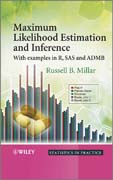
Maximum likelihood estimation and inference: with examples in R, SAS and ADMB
Millar, Russell
Applied Likelihood Methods provides an accessible and practical introduction to likelihood modeling, supported by examples and software. The book features applications from a range of disciplines, including statistics, medicine, biology, and ecology. The methods are implemented in SASthe most widely used statistical software packageand the data sets and SAS code are provided on a Web site, enabling the reader to use the methods to solve problems in their own work. This book serves as an ideal text for applied scientists and researchers andgraduate students of statistics. ÍNDICE: Preface Part 1: Preliminaries 1 A taste of likelihood 1.1 Introduction. 1.2 Motivating example. 1.3 Using SAS, R and ADMB. 1.4 Implementation ofthe motivating example... 1.5 Exercises.. 2 Essential concepts and iid examples 2.1 Introduction. 2.2 Some necessary notation.. 2.3 Interpretation of likelihood. 2.4 IID Examples... 2.5 Exercises.. Part 2: Pragmatics 3 Hypothesis tests and confidence intervals or regions 3.1 Introduction. 3.2 Approximate normality of MLEs. 3.3 Wald tests, confidence intervals and regions.. 3.4 Likelihood ratio tests, confidence intervals and regions.. 3.5 Likelihood ratio examples. 3.6 Profile likelihood.. 3.7 Exercises.. 4 What you really need to know 4.1Introduction. 4.2 Inference about g(_)... 4.3 Wald statistics - quick and dirty?. 4.4 Model selection.. 4.5 Bootstrapping... 4.6 Prediction.. 4.7 Things that can mess you up... 4.8 Exercises.. 5 Maximizing the likelihood 5.1 Introduction. 5.2 The Newton-Raphson algorithm.. 5.3 The EM (Expectation - Maximization) algorithm... 5.4 Multi-stage maximization. 5.5 Exercises.. 6 Some widely used applications of ML 6.1 Introduction. 6.2 Box-Cox transformations.. 6.3 Models for survival-time data.. 6.4 Mark-recapture models.. 6.5 Exercises.. 7 Generalized linear models and extensions 7.1 Introduction. 7.2 Specification of a GLM.. 7.3 Likelihood calculations.. 7.4 Model evaluation.. 7.5 Case study 1: Logistic regression and inverse prediction in R.. 7.6 Beyond binomial and Poisson models.. 7.7 Case study 2: Multiplicative vs additive models of over-dispersedcounts in SAS... 7.8 Exercises.. 8 Quasi-likelihood and generalized estimating equations 8.1 Introduction. 8.2 Wedderburn's quasi-likelihood.. 8.3 Generalized estimating equations. 8.4 Exercises.. 9 ML inference in the presence of incidental parameters 9.1 Introduction. 9.2 Conditional likelihood.. 9.3 Integrated likelihood... 9.4 Exercises.. 10 Latent variable models 10.1 Introduction. 10.2 Developing the likelihood.. 10.3 Software.. 10.4 One-way linear random-effects model.. 10.5 Nonlinear mixed-effects model.. 10.6 Generalized linear mixed-effects model.. 10.7 State-space model for count data. 10.8 ADMB template _les...
- ISBN: 978-0-470-09482-2
- Editorial: John Wiley & Sons
- Encuadernacion: Cartoné
- Páginas: 360
- Fecha Publicación: 09/09/2011
- Nº Volúmenes: 1
- Idioma: Inglés
